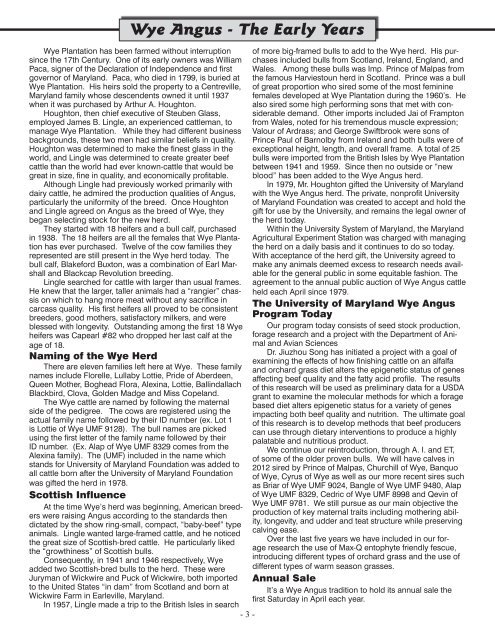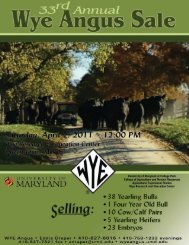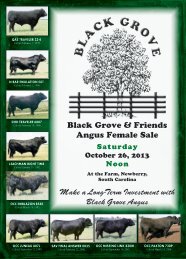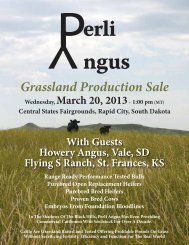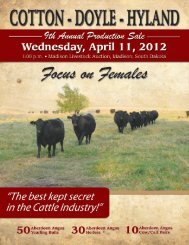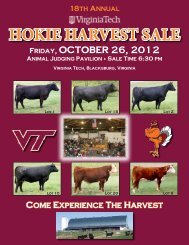View Catalog - Brubaker Sales and Marketing
View Catalog - Brubaker Sales and Marketing
View Catalog - Brubaker Sales and Marketing
You also want an ePaper? Increase the reach of your titles
YUMPU automatically turns print PDFs into web optimized ePapers that Google loves.
Wye Angus - The Early YearsWye Plantation has been farmed without interruption of more big-framed bulls to add to the Wye herd. His purchasesincluded bulls from Scotl<strong>and</strong>, Irel<strong>and</strong>, Engl<strong>and</strong>, <strong>and</strong>since the 17th Century. One of its early owners was WilliamPaca, signer of the Declaration of Independence <strong>and</strong> first Wales. Among these bulls was Imp. Prince of Malpas fromgovernor of Maryl<strong>and</strong>. Paca, who died in 1799, is buried at the famous Harviestoun herd in Scotl<strong>and</strong>. Prince was a bullWye Plantation. His heirs sold the property to a Centreville, of great proportion who sired some of the most feminineMaryl<strong>and</strong> family whose descendents owned it until 1937 females developed at Wye Plantation during the 1960’s. Hewhen it was purchased by Arthur A. Houghton.also sired some high performing sons that met with considerabledem<strong>and</strong>. Other imports included Jai of FramptonHoughton, then chief executive of Steuben Glass,employed James B. Lingle, an experienced cattleman, to from Wales, noted for his tremendous muscle expression;manage Wye Plantation. While they had different business Valour of Ardrass; <strong>and</strong> George Swiftbrook were sons ofbackgrounds, these two men had similar beliefs in quality. Prince Paul of Barnolby from Irel<strong>and</strong> <strong>and</strong> both bulls were ofHoughton was determined to make the finest glass in the exceptional height, length, <strong>and</strong> overall frame. A total of 25world, <strong>and</strong> Lingle was determined to create greater beef bulls were imported from the British Isles by Wye Plantationcattle than the world had ever known-cattle that would be between 1941 <strong>and</strong> 1959. Since then no outside or “newgreat in size, fine in quality, <strong>and</strong> economically profitable. blood” has been added to the Wye Angus herd.Although Lingle had previously worked primarily with In 1979, Mr. Houghton gifted the University of Maryl<strong>and</strong>dairy cattle, he admired the production qualities of Angus, with the Wye Angus herd. The private, nonprofit Universityparticularly the uniformity of the breed. Once Houghton of Maryl<strong>and</strong> Foundation was created to accept <strong>and</strong> hold the<strong>and</strong> Lingle agreed on Angus as the breed of Wye, they gift for use by the University, <strong>and</strong> remains the legal owner ofbegan selecting stock for the new herd.the herd today.They started with 18 heifers <strong>and</strong> a bull calf, purchased Within the University System of Maryl<strong>and</strong>, the Maryl<strong>and</strong>in 1938. The 18 heifers are all the females that Wye Plantationhas ever purchased. Twelve of the cow families they the herd on a daily basis <strong>and</strong> it continues to do so today.Agricultural Experiment Station was charged with managingrepresented are still present in the Wye herd today. The With acceptance of the herd gift, the University agreed tobull calf, Blakeford Buxton, was a combination of Earl Marshall<strong>and</strong> Blackcap Revolution breeding.able for the general public in some equitable fashion. Themake any animals deemed excess to research needs avail-Lingle searched for cattle with larger than usual frames. agreement to the annual public auction of Wye Angus cattleHe knew that the larger, taller animals had a “rangier” chassison which to hang more meat without any sacrifice inheld each April since 1979.The University of Maryl<strong>and</strong> Wye Anguscarcass quality. His first heifers all proved to be consistentbreeders, good mothers, satisfactory milkers, <strong>and</strong> wereProgram Todayblessed with longevity. Outst<strong>and</strong>ing among the first 18 Wye Our program today consists of seed stock production,heifers was Capearl #82 who dropped her last calf at the forage research <strong>and</strong> a project with the Department of Animal<strong>and</strong> Avian Sciencesage of 18.Dr. Jiuzhou Song has initiated a project with a goal ofNaming of the Wye Herdexamining the effects of how finishing cattle on an alfalfaThere are eleven families left here at Wye. These family<strong>and</strong> orchard grass diet alters the epigenetic status of genesnames include Florelle, Lullaby Lottie, Pride of Aberdeen,affecting beef quality <strong>and</strong> the fatty acid profile. The resultsQueen Mother, Boghead Flora, Alexina, Lottie, Ballindallachof this research will be used as preliminary data for a USDABlackbird, Clova, Golden Madge <strong>and</strong> Miss Copel<strong>and</strong>.grant to examine the molecular methods for which a forageThe Wye cattle are named by following the maternalbased diet alters epigenetic status for a variety of genesside of the pedigree. The cows are registered using theimpacting both beef quality <strong>and</strong> nutrition. The ultimate goalactual family name followed by their ID number (ex. Lot 1of this research is to develop methods that beef producersis Lottie of Wye UMF 9128). The bull names are pickedcan use through dietary interventions to produce a highlyusing the first letter of the family name followed by theirpalatable <strong>and</strong> nutritious product.ID number. (Ex. Alap of Wye UMF 8329 comes from theWe continue our reintroduction, through A. I. <strong>and</strong> ET,Alexina family). The (UMF) included in the name whichof some of the older proven bulls. We will have calves inst<strong>and</strong>s for University of Maryl<strong>and</strong> Foundation was added to2012 sired by Prince of Malpas, Churchill of Wye, Banquoall cattle born after the University of Maryl<strong>and</strong> Foundationof Wye, Cyrus of Wye as well as our more recent sires suchwas gifted the herd in 1978.as Briar of Wye UMF 9024, Bangle of Wye UMF 9480, AlapScottish Influenceof Wye UMF 8329, Cedric of Wye UMF 8998 <strong>and</strong> Qevin ofAt the time Wye’s herd was beginning, American breederswere raising Angus according to the st<strong>and</strong>ards thenWye UMF 9781. We still pursue as our main objective theproduction of key maternal traits including mothering ability,longevity, <strong>and</strong> udder <strong>and</strong> teat structure while preservingdictated by the show ring-small, compact, “baby-beef” typeanimals. Lingle wanted large-framed cattle, <strong>and</strong> he noticedcalving ease.the great size of Scottish-bred cattle. He particularly likedOver the last five years we have included in our forageresearch the use of Max-Q entophyte friendly fescue,the “growthiness” of Scottish bulls.Consequently, in 1941 <strong>and</strong> 1946 respectively, Wyeintroducing different types of orchard grass <strong>and</strong> the use ofadded two Scottish-bred bulls to the herd. These were different types of warm season grasses.Juryman of Wickwire <strong>and</strong> Puck of Wickwire, both imported Annual Saleto the United States “in dam” from Scotl<strong>and</strong> <strong>and</strong> born atIt’s a Wye Angus tradition to hold its annual sale theWickwire Farm in Earleville, Maryl<strong>and</strong>.first Saturday in April each year.In 1957, Lingle made a trip to the British Isles in search- -


